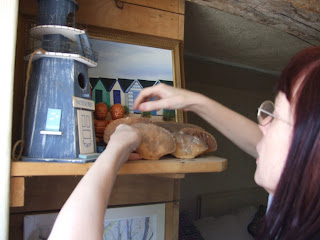This week we had to produce our own 'Cabinets of Curiosities' - either evoking the early collectors and museums that sought to inspire awe - or the later collectors like Cornell, Warhol, Dion, that were more iconoclastic and rebellious in their Collecting - and in their curating. In the process we were also exploring the nature and pleasures inherent in collecting - and that was supposed to emerge in our reflective critical commentary.
1. Explain
your process (medium and technique). How was it made? Which art materials and approached did you use
and why?
This Cabinet could be said to
have been influenced by all the (20th and C21st collectors that we
studied: Cornell, Warhol and Dion. I built this Cabinet in what we call the
‘front room’ in the UK
The 'cabinet' itself is not made
from oak or mahogany or even of proper pine - it is literally 'bodged' - made
from wood still wet, that then dried and changed shape in the drying. In the
process, gaps appeared between planks - and nothing is 'perfect'. Thus the
Cabinet itself is a small social commentary - refuting refined woods and
artistic carpentry - and celebrating the rustic and homespun. It is definitely
not the sort of Cabinet or display case that you would expect to find in this
sort of room - nor is it the sort of case that would normally be used to
display your most cherished possessions.
Typically the front room is a formal
room with formal decorations: it can be the ‘statement’ room of the house that
tells people who you are and what you value. In a capitalist, wealth-obsessed
society, it can be the space where you display your wealth though the objects
you collect and display. It is where you tell people about your status – and
your ‘taste’. We divide ourselves one from another by wealth, status and taste…
Ornaments can be purchased to decorate this room – and are usually expensive. Similarly art work may be displayed in such a room and as with the art work in
a gallery or a museum – it is also formal and produced by named artists – or
could be copies of works by named artists.
Cornell, Warhol and Dion
wanted to challenge the formality of museums, the taxonomy and classification
systems themselves, all the rigidity inherent in galleries and in curation.
They wanted to challenge what is considered worth displaying – and how it is displayed.
In the process of creating their Cabinets they produced their own art works
that were interesting, curious or beautiful in and of themselves – but that
also challenged the status quo of curation – and even of society and its
values. In just this way I wanted to create my own Cabinet - I wanted it to
evoke the beauty of the seaside - but also to comment on taste/wealth/society.
I created my representations of the seaside by placing found objects from the
seaside itself – rocks, shells and crab shells – alongside ‘cheap’ art or mass
produced art – or art made by family and friends, or given by family and
friends… and challenge what is acceptable to display in a formal front room –
and what ‘good taste’ is.
2. Describe
the idea behind your artwork. What story or message does it get across? What does it mean to
you?
The simplest idea behind my
art work is that is an evocation of the natural world – especially that found
by the sea – with an emphasis on the UK Norfolk Norfolk
I have placed skulls amongst
the seashells for I find these beautiful – but I also like the juxtaposition of
life, the sea, and death, the skulls themselves; that is the fate of us
all.
The boat, the pictures, and
various items there were given to me by family and friends as they know my love
of the seaside. The items tend to be not expensive, perhaps mass produced – but
beautiful for all that; beautiful also for the love with which they were
purchased and given to me.
3. Why did you create it? What are your reasons for creating that
specific art piece? What do you want your audience to feel and think
while observing it?
I created this piece to remind
me of the seaside and the people that I love. I also wanted it to be
iconoclastic: to disrupt notions of what is acceptable and unacceptable art
work in the formal room of a house. I wanted this to challenge notions of good
taste – and of buying social status and approval by the art and ornamentation
that you purchase and display. But I wanted this also to intrigue – I want people to
stand and stare and to think. I want them to remember what they like about
being at the sea. I want people to go away and re-discover their child selves;
to collect shells and stones – and display them themselves in their own homes.
Whilst there is an element of confrontation in the piece – my main hope is that
it inspires joy…




No comments:
Post a Comment